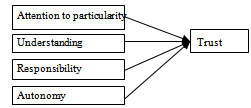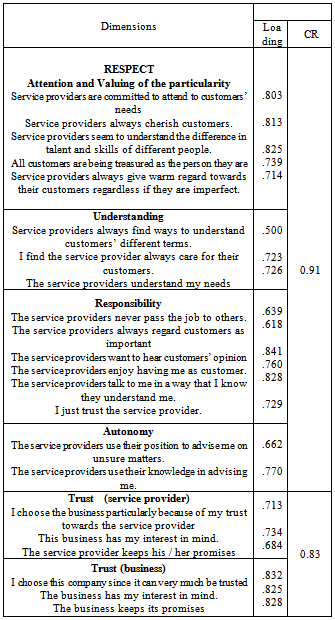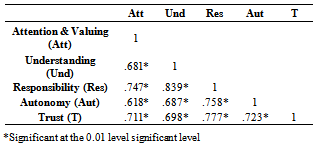-
Paper Information
- Next Paper
- Previous Paper
- Paper Submission
-
Journal Information
- About This Journal
- Editorial Board
- Current Issue
- Archive
- Author Guidelines
- Contact Us
Human Resource Management Research
p-ISSN: 2169-9607 e-ISSN: 2169-9666
2013; 3(1): 16-20
doi:10.5923/j.hrmr.20130301.04
Respect Your Customers and Earn Their Trust: An Empirical Evidence
Siti Haryati Shaikh Ali , Norudin Mansor , Zalinawati Abdullah
Faculty of Business Management, University Teknologi MARA (Terengganu), 23000, Dungun, Terengganu, Malaysia
Correspondence to: Siti Haryati Shaikh Ali , Faculty of Business Management, University Teknologi MARA (Terengganu), 23000, Dungun, Terengganu, Malaysia.
| Email: |  |
Copyright © 2012 Scientific & Academic Publishing. All Rights Reserved.
One of the most effective ways of establishing a quality relationship with customers is by respecting them. The purpose of this paper is to thoroughly examine the concept of respect and how it affects customers’ trust. Having developed a concrete model, we intend to determine the moderation effect of gender on the whole relationship. The framework of this study is developed from existing literature and empirical study of customers of service sectors in a few capital cities in Malaysia. Data from questionnaire survey of 469 respondents were analysed using Pearson correlation and regression analysis. Hierarchical Multiple Regression was further being used to estimate the importance of each dimension of respect on trust.
Keywords: Trust, Respect, Responsibility, Understanding
Cite this paper: Siti Haryati Shaikh Ali , Norudin Mansor , Zalinawati Abdullah , Respect Your Customers and Earn Their Trust: An Empirical Evidence, Human Resource Management Research, Vol. 3 No. 1, 2013, pp. 16-20. doi: 10.5923/j.hrmr.20130301.04.
Article Outline
1. Introduction
- The growth of service sector in today’s competitive business environment is undeniably very important. Service businesses are finding ways to compete against one another. In doing so, at all times business providers are looking for new ways to differentiate their service from competitors. At the same time, service companies need to find ways to retain their customers and thus compete better with their rivals. Regardless of the effort, one aspect remains the same, service businesses need to gain trust from their customers. Extant of literature has discussed various factors affecting trust, but none has touched on the dimensions and effect of respect. Earlier study on respect has been conducted by[1]. However, we feel that the dimensions and measurement in the study were not comprehensive. In order to improve the service operationalization, this paper is committed to provide a strong theoretical and empirical support on respect. Only with strong dimensions of respect, calculative effort in gaining customers’ trust can be determined.
2. Literature Review and Hypotheses
- Trust is selected due to its importance in building good relationship especially in addressing service day-to day dealings. The role is especially important in a multicultural country like Malaysia. As such, the issue of trust andrespect are not something that can be taken for granted.
2.1. Developing Trust
- Trust can be defined as one party’s confidence in an exchange partner’s reliability and integrity[2]. It is be considered as an important component in building good relationship with customers[3]. Trust is chosen in this case based on the work done by[4] which states that trusting the service provider is the most important relational outcome of long-term relationships for customers across service categories. The interpretation of trust varies from one author to another. However, the whole concept does not go far from the inner feelings developed towards one person or organization. For instance,[5] believe that there are three types of trust can be developed in organizations; namely trust in the salesperson, trust in the store and trust in branded products. In the similar manner,[6] describe the concept of trust as the participation of at least two parties, a trustor and a trustee. The trustor is the party who places him or herself in a vulnerable situation under uncertainty. On the other hand, the trustee is the party who places in whom the trust is placed, making him or her as the person who has the opportunity to take advantage of the trustor vulnerability. Besides that, extant of literature have shown how a mixed feeling of trust have developed due to situations and circumstances. For example[7] is more concerned towards the people desire to maintain their respectful relationship. On the other hand, there are authors who can prove the relationship between service provider also include their trust towards the store as well[8][9]. There are studies that show the association between tangible aspects of the store with trust. Those tangible aspects include store image[10] and branded items of products sold[11]. One thing for sure, it is trust that differentiates the relationship. The feeling of trust cannot easily developed and it actually develops over timer time.
2.2. Respecting Customers
- There is nothing unusual about the term ‘respect’. Each time the word respect is mentioned, the term is used colloquially as if everyone understands. However, in the actual academic world, to understand respect is very complex. Even though the term is widely used in the society, its dimensions and operationalizations are unclear. In the field of marketing, the word respect has been used to reflect it as an important determinant of relationship marketing success[12]. Despite what has been said, the concept is poorly defined[13] and[14] consider it as being totally ignored in the marketing literature. To date, not many empirical researches have been conducted on the area of respected – not respected. The concept of respect by many researchers is usually based on the work by[14]. He was the first philosopher to acknowledge respect for people as central to moral theory which he believes as “morally obligatory to respect each person as a rational agent”[15]. Even though respect can be considered as an “old” concept judging from the extensive usage of the word itself, respectful behaviour actually varies and making it a deceiving concept after ll.[13]. This research will adopt the concept of respect as caring, which involves the feeling of care and loving towards others[16]. The concept is chosen as it shows an important basis in conceptualizing respect towards customers[17]. Care respect concept as proposed by[17] is thought to be the best concept due to its unique blend of morality, compassionate, responsive and caring for other individuals.[17] proposes a concept of respect with three dimensions; namely attention and valuing of the particularity, understanding and responsibility. The notion is supported by an empirical study by[1]. However, we realize that the dimensions proposed by them were inadequate. Therefore, we are proposing an additional dimension of autonomy should be added to the latter version. Proposed dimensions of respect are as shown in ( Figure 1) below:
 | Figure 1. Proposed Framework for the Study |
2.2.1. Attention and Valuing to Particularity
- The first dimension of respect proposed is attention and valuing to particularity. This dimension is about appreciating and cherishing each person as unrepeatable individual[16]. It also the need to be sympathetic and concern and involved in engagement with participation of others. Generally, this dimension urges the need to value differences in others and not viewing it as a barrier to be overcome.
2.2.2. Understanding
- The second dimension, understanding carries the idea to understand in his own terms. Understanding is not just simply a precondition to care respect but also trying to understand a person’s consciousness, his activities and his purposes[18]. This dimension also means that customers are well understood and not making any assumptions towards them. All in all, this suggests that to understand a customer requires feelings of sympathetic, concerned and involved interest, which can be considered as an expression of valuing and constitutive of respect.
2.2.3. Responsibility
- The third dimension of respect is responsibility which highlights our individual responsibility as a care respecter in the community. This dimension involves caring for a person in the sense of helping them to pursue their end, acting to promote their goods and assisting them to satisfy their needs and wants[16].
2.2.4. Autonomy
- Autonomy can be defined as the individual power or ability to make one’s own choice independent of others[19]. In the research the authors further describe autonomy as “constrained freedom” which means involved parties are able to make “certain decisions”. In other words, adopting autonomy in respect means that customers who strive for autonomy make their own choices, independent of others. It should be included as one dimension of respect as it signifies ‘the power’ possess by the customers in taking certain action and thus fulfils the basic human needs in the normal situations[20]. It is expected that positive relationship between respect and trust will be developed through the following hypotheses:H1 : Attention and valuing to particularity is significantly associated with trustH2 : Understanding is significantly associated with trustH3: Responsibility is significantly associated with trustH4: Autonomy is significantly associated with trust
3. Methodology
- In completing this study, the following method is followed:
3.1. Sample and Data Collection
- The population for this study is customers from service sector in Malaysia. The survey of this study was conducted on 459 customers from three service organizations Kuala Terengganu, Kuala Lumpur, Georgetown and Johor Bahru. All selected types of service organization chosen was based on Bowen Taxonomy of services. According to the classification, service businesses can be divided into three categories; namely services directed at individuals (high customer contact), services directed at individual’s property (moderate to low customer contact) and lastly services that provide moderate contact (for instance fast food restaurant). The selected services were hospitals, banks and airlines representing each named category respectively. Participation by all the named services was purely voluntary. For hospitals, only those patients from out-patients departments were chosen. Since the respondents were wide spread in the three types of organizations in different states in Malaysia, university students were trained to serve as data collectors. They were chosen on the basis of some background experience in marketing researches.
3.2. Data Collection
- Data was collected using a structured questionnaire with questions in prearranged order. The questionnaire items were adapted from different sources to suit the study. Items for respect were adapted from[16],[13],[1] and[18]. Items for trust were adapted from[21]. All items were measured on a seven-Likert scale ranging from 1 “strongly disagree” to 7 “strongly agree”. Data obtained from 480 questionnaires were analysed using SPSS statistical package and proposed all the four dimensions tested for relationship analysis. However, 21 questionnaires were voided due to incomplete data, resulting in 459 usable responses.
3.3. Analyses and Results
- Our sample size was 459 of whom 159 were male and 300 were female. Majority of the respondents were in the bracket group of 23 to 30 (40 percent) and in the bracket group of 15 to 22 (24 percent) years old. More than half of the total respondents (60 percent) were employed. In terms of education, 44 percent of the total respondents hold a university degree and can be considered as professionals.Factor analysis was performed on all questionnaire items to establish their suitability for performing subsequent multivariate analysis. The maximum likelihood extraction method was employed for the analysis. Promax rotation method was applied and all items with high cross-loadings were removed. The results presented are based on parsimonious sets of variables, guided by conceptual and practical considerations with loadings of 0.50 and above[22] and cross loadings below 0.20. We started off with 37 items loading on six factors. After a few rounds of factor analysis, we finally ended up with 27 items loaded well on all dimensions as shown in Table 1 below. Factor analysis also gives a high total of 0.961 Keiser-Meyer-Olkin measure of sampling adequacy and significant value (p=0.000) for Bartlett’s Test of Sphericity. Besides that reliability testing was conducted to test the reliability of the questionnaire. Cronbach Alpha (as shown in Table 1) indicates factor exceeding 0.500, which assumes the reliability of scales used.
|
4. Results
- Results of the analysis are as follow:
4.1. Correlation among Variables
- Pearson correlation was used to test for association. The result of correlation (as shown in Table 2) supports the notion that there are significant positive correlations between trust and four independent variables; namely attention and valuing to the particularity, understanding, responsibility and autonomy. All the four dimensions of respect (attention to the particularity, understanding, responsibility and autonomy) demonstrated a significant correlation with trust (r = 0.711, 0.698, 0.777 and 0.723).
|
4.2. Regression Analysis among Variables
- Further analysis using multiple regression analysis (as shown in Table 3) was conducted. The test was conducted in two stages. In the first stage is to analyse the effect of respect dimensions on trust as a whole. Four dimensions of respect (attention and valuing of the particularity, understanding, responsibility and autonomy) are analysed against trust. The result from ANOVA table indicates that all four dimensions are found to contribute significantly to trust (p = 0.000). However, when the result is analysed individually, only three dimensions of respect (attention and valuing of the particularity, responsibility and autonomy) seem to have significant effect on trust. From Table 3, it is evident that attention and valuing of the particularity (β =0.267 , p = 0.000), responsibility (β = 0.369, p = 0.000) and autonomy (β = 0.173, p= 0.000) show significant relationship to trust. Thus, the result indicates that H1, H3 and H4 are supported. On the other hand, there is no significant relationship between understanding and trust (β = 0.099, p = 0.083). Therefore, hypothesis 3 (H3) is not supported.
| ||||||||||||||||||||||||||||||||||||||||||
4.3. Division of Trust
- From the literature it is understood that the feeling of trust felt by customers can be divided into two, those include the trust towards the service provider and the trust towards the business itself[5]. We want to determine in the service paradigm, customers are keen towards which kind of trust. Therefore, we run another regression analysis to see the effect of trust more clearly. This time trust is separated into two different subsections; namely trust towards business and trust towards service provider (as shown in Figure 2).
 | Figure 2. Division of Trust |
4.3.1. Comparison of Trusts
- Figures must be numbered using Arabic numerals. Figure captions must be in 8 pt Regular font. Captions of a single line (e.g. Figure 2) must be centered whereas multi-line captions must be justified (e.g. Figure 1). Captions with figure numbers must be placed after their associated figures, as shown in Figure 1.
|
4.4.2. Table Captions
- . 364-371, 2011.• Referencing information for a webiste:e.g. Online Available: http://journal.org/ajb• Referencing information for a master's thesis or doctoral dissertation: Author name, Title, Thesis or Dissertation, University/Lab/Institute, Country, Year.e.g. A. Karnik, "Performance of TCP congestion control with rate feedback: TCP/ABR and rate adaptive TCP/IP", M. Eng. thesis, Indian Institute of Science, India, 1999.• Referencing information for a technical report: All author names, Title, University/Lab/Institute/Company,Year.e.g. J. Padhye, V. Firoiu, D. Towsley, "A stochastic model of TCP Reno congestion avoidance and control", Univ. of Massachusetts, Tech. Rep. 99-02, 1999.• Referencing information for a standard: Title, Year.Wireless LAN Medium Access Control (MAC) and Physical Layer (PHY) Specification, IEEE Std. 802.11, 1997.
5. Conclusions
- The version of this template is V1. Most of the formatting instructions in this document have been compiled.
 Abstract
Abstract Reference
Reference Full-Text PDF
Full-Text PDF Full-text HTML
Full-text HTML
